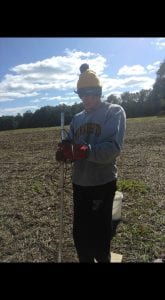Ian Goralczyk, Nathan Sedghi, and Ray Weil
University of Maryland, Department of Environmental Science & Technology
Cover crops are subsidized by taxpayers for use on more than 600,000 acres of agricultural fields in Maryland as part of an initiative to protect water quality and the Chesapeake Bay. As cover crops grow and take up nutrients, the water leaching from fields is cleaned up, especially with regard to nitrogen. However, the way that cover crops are typically managed may not be optimal for improving water quality. The Weil lab’s previous work has shown that the effectiveness of cover crops in reducing N leaching during the winter is dramatically affected by how early the cover crops are established, with cover crops planted in mid-October having little impact on N leaching compared to those planted a month earlier. The challenge is to find ways of getting cover crops established in early September, a time frame usually not possible with the typical practice of drilling cover crop seed after harvesting the corn or soybean cash crop. For this reason we studied a mixed species cover crop (radish, rye, and crimson clover) that was interseeded into standing soybeans canopies as compared to the standard practice of post-harvest drilling, and a no-cover crop control. We conducted the replicated experiment on two coastal plain fields with soils of contrasting textures formed in silty/clayey sediments, and in sandy sediments.

This experiment was established at the Beltsville Facility of the Central Maryland Research and Education Center, with funding from Shore Rivers, LLC and the Maryland Soybean Board. The early planted cover was planted by broadcasting seed into a standing soybean canopy at leaf yellowing using a hiboy air-seeder on September 11, 2017. In each field, suction lysimeters were installed (Figure 1) to one-meter depth and samples were collected using a 85 kPa vacuum approximately every two weeks between December 17, 2017 and May 7, 2018. Soil pore water samples were filtered to remove particulate matter and frozen until they were analyzed for NO3-N and NH3-N on a LaChat® Flow Injection Analyzer.
One field had a silt loam surface texture and a clay loam subsoil (Russet-Christiana Complex). The other field had a loamy sand surface texture and sandy loam subsoil (Evesboro-Downer Complex). By utilizing fields of contrasting soil textural classes we can determine the effectiveness of these cover cropping methods with a range of soil conditions in order to broaden the scope of this study.
Cover crop use made a major difference in nitrate concentrations measured in the porewater collected at 1 m depth (Figure 2). Nitrate concentrations were reduced most where cover crops were established the earliest. As expected, the nitrate concentrations in the leaching water, as well as the impact of early cover crop establishment, were greatest on the sandy soil site.
While there were some individual samples that exceeded the EPA safe drinking water standard for nitrate-N (10.0 ppm), the average of all individual treatments was below this standard, and nitrate concentrations were consistently lower for the early interseeded cover crop treatment. A major reason why lower nitrate concentrations at one meter depth were observed for cover cropped plots is that the nitrate was taken up by cover crops roots and largely translocated to the aboveground plant tissue. This process captures the N before it leaves the potential rooting zone and recycles it to the surface soil where it may be released for use by future crops. This release could lead to decreased need for fertilizer nitrogen application to the following corn crop. Our data suggest that if similar cover crop interseeding practices (using aerial or ground-based methods) were applied on a large scale on commercial farms, the reduction in nitrogen loading to the Chesapeake Bay could be substantial. We can also conclude that early-planted cover crops are effective for reducing nitrate leaching on soils with a range of textural classes.
While these results are promising, it is important to note that they represent only one year out of a three year project, and that more data will be collected on different fields and with different cover cropping methods. We hope to provide farmers with guidance on optimizing cover crop species mixtures, planting dates and methods in order to enhance the impact of cover crops on nitrogen pollution while also improving soil health and farm profitability.

